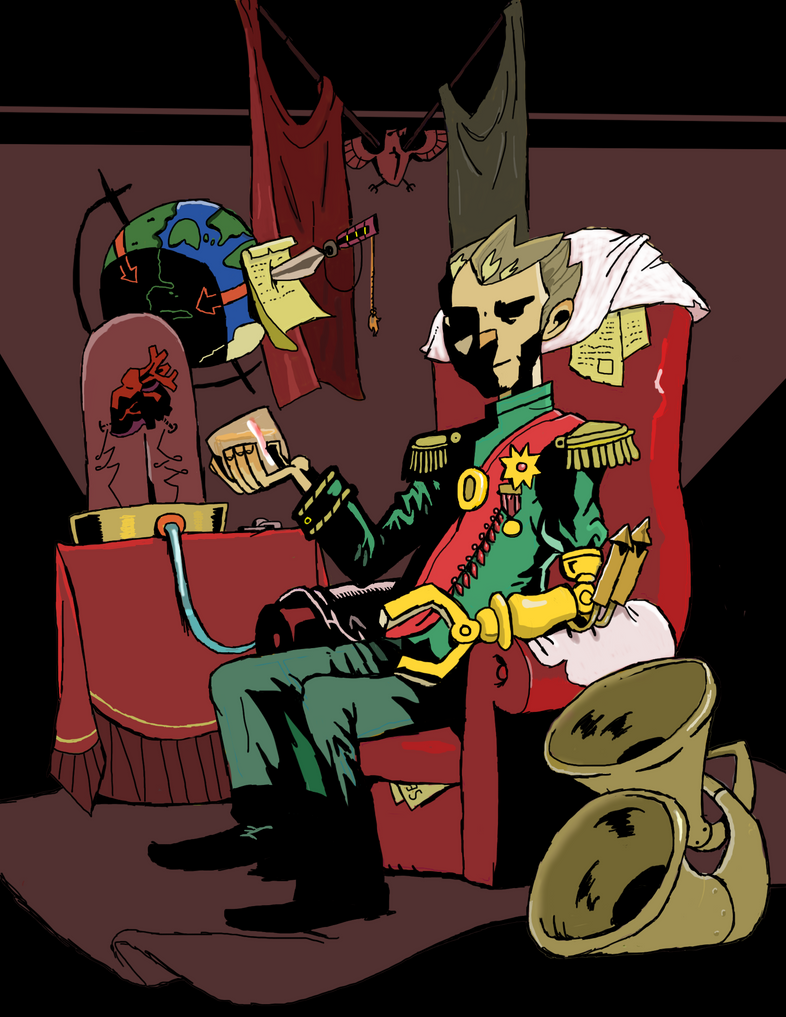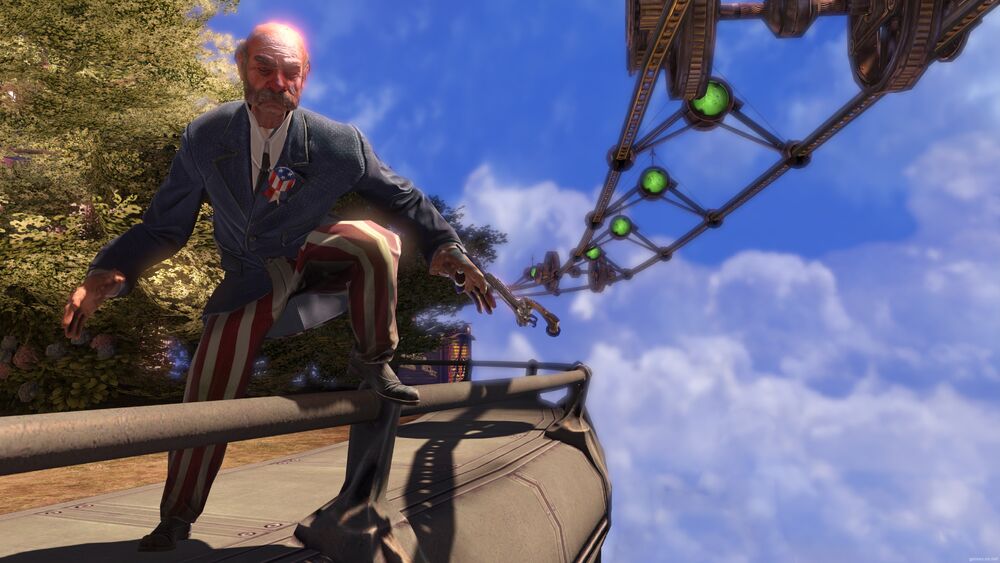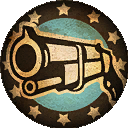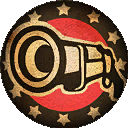I live in a world of half-formed ideas. Seeing the development of movies and video games, especially in that fertile first ground before everything has been finalized, where the really wild ideas grow. Often I'll like a game's concept art more than I like the finalized version.
With Bioshock Infinite's second DLC dropping on Tuesday, I wanted to revisit my copy of the
The Art of Bioshock Infinite, crawl around in the game's primordial ooze, and discuss some of the cool things I find there. Beware!
I have included some spoilers, so be warned. I probably don't need to include that, but I will.
Fink's Workers
Jeremiah Fink is Columbia's resident robber-baron plutocrat. A mixture of Henry Ford and an evil version of Henry Ford, he runs the city's
only corporation. He pays his employees in money that is worthless outside of his own store, deliberately imports "undesirables" so that they can be exploited, and sloganeers obnoxiously much the same way Andrew Ryan did in Bioshock. Fink's brand can be seen on nearly everything: vigors, vending machines, turrets, even the slum district where his army of tenement laborers live.

In the finalized version of the game, as you wander his factories, you see his employees: indigent, oppressed, and sad, but somehow lacking in the visual punch much of the rest of the game has. Where everything else in the game is larger than life, the poverty and abuse the workers suffer feels stunted. I found myself looking to other media that shows class warfare and abuse, and this came up lacking. Hundreds burned alive in the Triangle Shirtwaist Fires, the lower classes locked below decks on the Titanic, people accidentally ground to sausage in
The Jungle. None of this, and nothing like it, exists in Columbia. Heck, during an elevator ride you see the interior of Fink's factory, and this interior section looks entirely automated: stock shipping even while the employees are actively burning the factory down. An automated factory? If these poor people don't want to be there and they're not needed,
what are they even doing there.
All this was frustrating. Then, in the concept art for Finkton, there are several extremely inhumane-looking machines that originally served as part of Fink's manufacturing operations. As you can see, some of them suggest that the employees are tortured if they slow down, or simply tortured continuously. Some machines feature amputees belted or strapped to prosthetic extensions. They thus could fill several roles not met by the "standard human" employees: they underscore the danger to life and limb employees face in these factories. They serve as interesting setpieces to make this part of the game distinct from the rest.
Finally, and perhaps most importantly, they could serve to more adequately explain the Handymen. Tears, automatons, and vigors: the technology that resulted in Handymen could be any of these, and yet it's not clearly any of these. Rapture apparently relied on the Big Daddies to maintain it structurally (they dug foundations and repaired leaks) and to protect ADAM-harvesting Little Sisters. They arose from the technological development of splicing. There is no such visual, philosophical, or technological precursor or need for the Handymen.
Why They May Have Gone In a Different Direction
I wasn't sure why such great imagery would have been cut out of the game in favor of the workers we end up seeing. It seemed in line with the game's intent--portraying Fink as an evil tycoon of the highest order of villain (
They named him Fink, for crissakes), up until they started equating the Vox to the very hierarchy they were fighting against. My assumption was that this stuff was cut because the creative staff felt the current model served the story equally well while being easier to model and animate.
Vigor Junkie and Snake Oil Salesman
Vigors were badly underrepresented in Bioshock Infinite. Originally I disagreed: we had two enemies based on vigors, whereas in Bioshock no enemies use anything that looks like the plasmids available to the player. They're obviously spliced, but you don't ever shoot up with a bottle of Crawl On Ceiling or Teleport. This was even more frustrating in Bioshock 2, where interviews with the creative leads promised "expert splicers" who knew how to handle their plasmids... but ended up being Brute Splicers, who just use a combination of tonics for their trademark physicality and endurance. So I was excited when we had a Murder of Crows themed enemy AND a Devil's Kiss themed enemy, even if only one is adequately explained.
After an examination of that, I've changed my mind. In Bioshock and Bioshock 2, enemies at least splicers: although they don't use plasmids the player has available, they're at least participating in the same world as you. In Bioshock Infinite, most of your enemies don't use vigors, or even seem aware of them. You pull a grenade launcher on a guy with a truncheon, he'll dive behind a box full of vigors for cover. He'll sit there, surrounded by gallons of a fluid that, with one sip, would let him throw fireballs or shoot lightning out of his eyes, and then he'll come running at you with his dumb stick. Just drink the potion, man! The people you're fighting are just regular dudes and ladies (Columbia's equal-opportunity military is pretty impressive), and it doesn't make any sense. The aggressive, suicidal rampages made sense with splicers: they were drugged up,
mind-controlled lunatics who want to feed your blood to little girls. These people presumably have families, friends, some remaining desire to not get sawed in half.
The Splicers in Bioshock prevent the omnipresent advertisements, vending machines and EVE hypos from seeming disingenuous or out-of-place. While relatively few enemies actually use the plasmids the player can equip, plasmids still inform nearly every aspect of the world. That same design consistency isn't covered in BSI.
Worse, BSI has moments that could really benefit from these distinctly different characters: the fight/flight moments. Often when you arrive in a completely new place, people haven't yet identified you as the enemy, and you won't get attacked until you violate the law: rob, murder, trespass. However, most of these events focus on police and guards preventing you from robbing a store. Junkies could have further diversified those events, while simultaneously re-grounding vigors in the world.
Why They Were Cut:
The vigor junkies see new life as Frosty Splicers in
Burial At Sea, but both they and the other enemies seen in the art book presumably were cut for a pretty obvious reason: the mechanics that grew alongside the designs were abandoned. The snake-oil salesman
Automatons
There is concept art for Benjamin Franklin and Thomas Jefferson Automated Patriots that were cut. That's disappointing for a lot of reasons: the Key/Sword/Scroll philosophy that appears in the temple at the beginning of the game is almost totally gone by hour 2, and Jefferson and Franklin won't be mentioned again until the asylum later in the game. There are lots of other automatons in the original art that never made it into the game, including a few that are purely nonthreatening, but I think it is the absence of the Franklin and Jefferson that is the most disappointing as a fixture of the story.
Why It was Cut:
Unlike the other stuff, I find automatons kind of a mystery
in general. They're cool and they bring the game a certain
je ne sais quoi, diversifying the enemy ranks in a way that it really needed, but I have no idea how they fit in with tears or vigors. It is expressly mentioned in the art book that automatons were a fascination of the era, but that's it. The Motorized Patriots are initially introduced as props in a museum, reciting patriotic gibberish, but that really supports presenting all three Fathers getting equal time.
The cut may be the way that the two factions' Motorized Patriots are distinguished: Washington for the Founders, and a devilish Lincoln for the Vox, but the distinction between the two factions hardly ever comes up as a function of gameplay and friendly Patriots are always identified by green lights anyway, so that hardly seems like an adequate explanation.


































